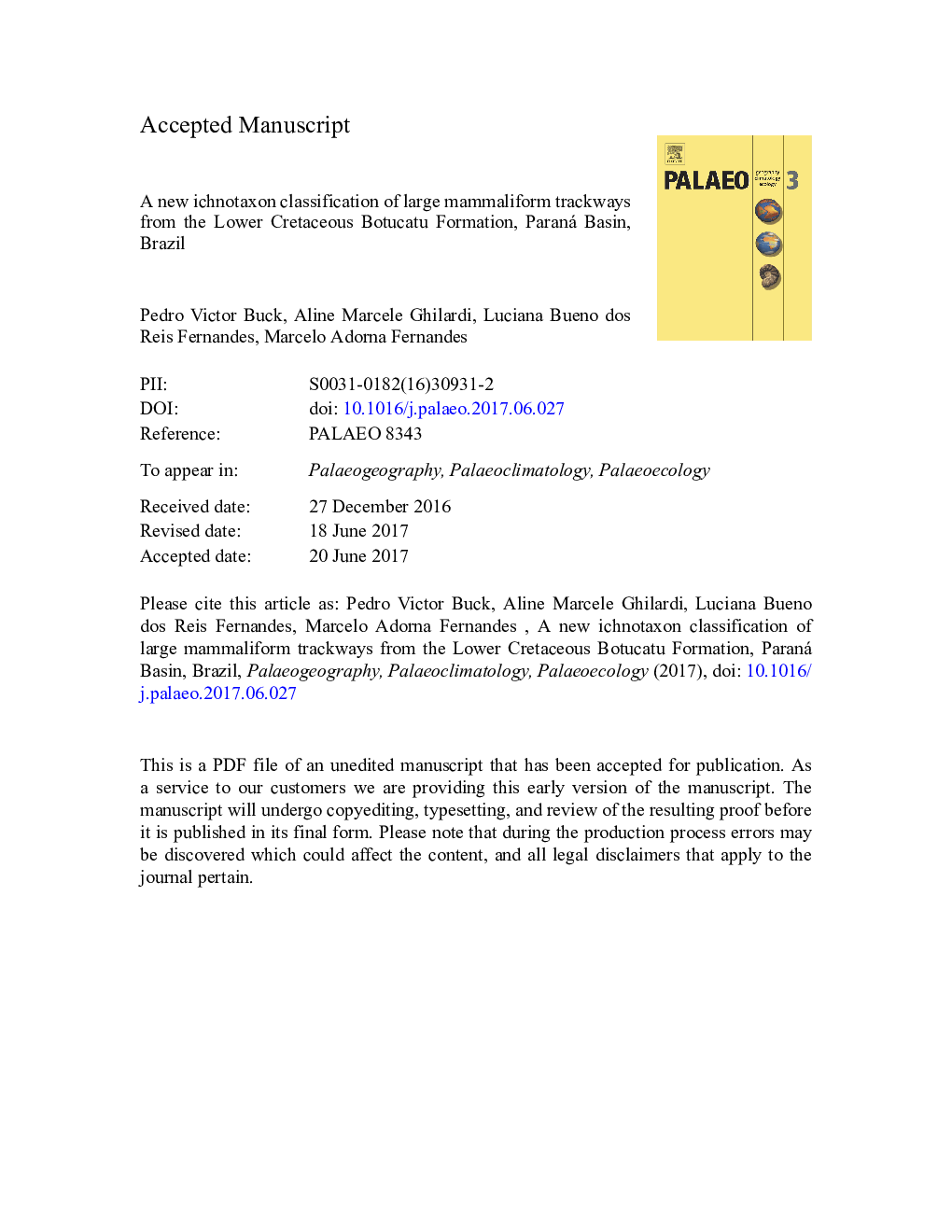| کد مقاله | کد نشریه | سال انتشار | مقاله انگلیسی | نسخه تمام متن |
|---|---|---|---|---|
| 8868666 | 1622107 | 2017 | 47 صفحه PDF | دانلود رایگان |
عنوان انگلیسی مقاله ISI
A new ichnotaxon classification of large mammaliform trackways from the Lower Cretaceous Botucatu Formation, Paraná Basin, Brazil
دانلود مقاله + سفارش ترجمه
دانلود مقاله ISI انگلیسی
رایگان برای ایرانیان
کلمات کلیدی
موضوعات مرتبط
مهندسی و علوم پایه
علوم زمین و سیارات
فرآیندهای سطح زمین
پیش نمایش صفحه اول مقاله

چکیده انگلیسی
During the Early Cretaceous, a large area in Brazil and other South American countries was covered by an extensive paleoerg field, the Botucatu Desert. The Araraquara County (São Paulo State, Brazil) contains some of the most diverse ichnological assemblages in the Botucatu Formation. Mammaliform trace fossils from the Botucatu Formation are of great interest, as they may represent the only record of Lower Cretaceous Mammaliamorpha from Brazil. These trace fossils can be grouped into two distinct classes, based on the dimensions of the footprints. The larger morphotype is described and classified as a new ichnotaxon, Aracoaraichnium leonardii igen. nov. isp. nov., with a discussion of preservational features and paleoecological aspects. This morphotype can be differentiated from Brasilichnium Leonardi, 1981 by digit morphology, with digits III and IV being larger and sub-equal in size. The tracks are mesaxonic, unlike Brasilichnium, which is ectaxonic, and the stride is proportionally smaller, suggesting a trackmaker with shorter limbs in relation to body length. Another characteristic that reinforces the new ichnotaxon is the larger size of the footprints of Aracoaraichnium igen. nov. Footprints representing intermediate ontogenetic stages between Brasilichnium and the larger morphotype are not observed, suggesting that the two track types were made by different taxa. Compared with others tetrapod ichnotaxa, the new ichnotaxon is characterized by differences in the number and morphology of the digits, track morphology, the degree of heteropody, and locomotor parameters. Tracks with good preservation quality were likely originally produced in the humid subsurface, below the surficial dry sand layer. Tracks with smaller dimensions, and trackways with the presence or absence of the manus, may be due to variable degrees of impression into subsurface layers, and substrate heterogeneity. The Aracoaraichnium igen. nov. trackmakers probably inhabited areas near the desert, making occasional incursions into desert areas, while Brasilichnium trackmakers may have been mostly nocturnal residents of the desert environment.
ناشر
Database: Elsevier - ScienceDirect (ساینس دایرکت)
Journal: Palaeogeography, Palaeoclimatology, Palaeoecology - Volume 485, 1 November 2017, Pages 377-388
Journal: Palaeogeography, Palaeoclimatology, Palaeoecology - Volume 485, 1 November 2017, Pages 377-388
نویسندگان
Pedro Victor Buck, Aline Marcele Ghilardi, Luciana Bueno dos Reis Fernandes, Marcelo Adorna Fernandes,